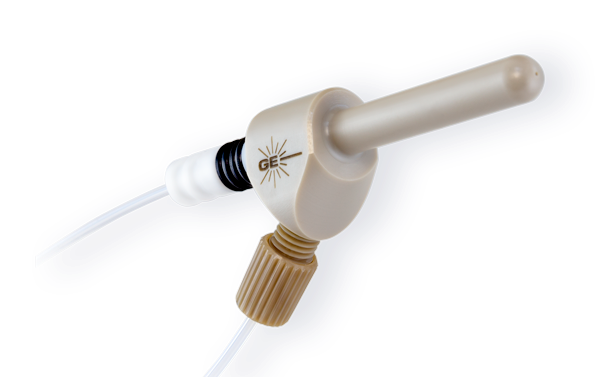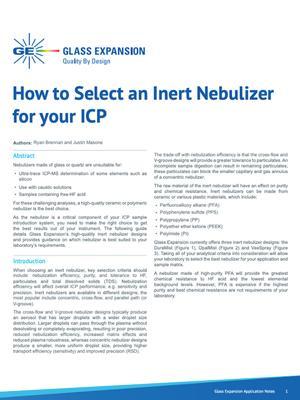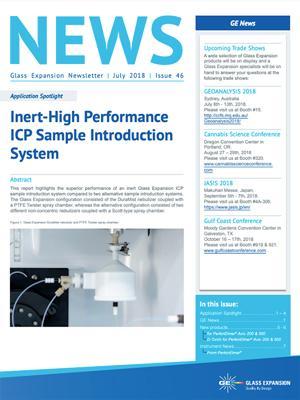Abstract
Nebulizers made of glass or quartz are unsuitable for:
- Ultra-trace ICP-MS determination of some elements, such as silicon
- Use with caustic solutions
- Samples containing free-HF acid
For these challenging analyses, a high-quality ceramic or polymeric nebulizer is the best choice.
As the nebulizer is a critical component of your ICP sample introduction system, you need to make the right choice to get the best results out of your instrument. The following guide details Glass Expansion’s high-quality inert nebulizer designs and provides guidance on which nebulizer is best suited to your laboratory’s requirements.
Introduction
When choosing an inert nebulizer, key selection criteria should include: nebulization efficiency, purity, and tolerance to HF, particulates and total dissolved solids (TDS). Nebulization efficiency will affect overall ICP performance, e.g. sensitivity and precision. Inert nebulizers are available in different designs; the most popular include concentric, cross-flow, and parallel path (or V-groove).
The cross-flow and V-groove nebulizer designs typically produce an aerosol that has larger droplets with a wider droplet size distribution. Larger droplets can pass through the plasma without desolvating or completely evaporating, resulting in poor precision, reduced nebulization efficiency, increased matrix effects and reduced plasma robustness, whereas concentric nebulizer designs produce a smaller, more uniform droplet size, providing higher transport efficiency (sensitivity) and improved precision (RSD). The trade-off with nebulization efficiency is that the cross-flow and V-groove designs will provide greater tolerance to particulates. Incomplete sample digestion can result in remaining particulates; these particulates can block the smaller capillary and gas annulus of a concentric nebulizer.
The raw material of the inert nebulizer will have an effect on purity and chemical resistance. Inert nebulizers can be made from ceramic or various plastic materials, which include:
- Perfluoroalkoxy alkane (PFA)
- Polyphenylene sulphide (PPS)
- Polypropylene (PP)
- Polyether ether ketone (PEEK)
- Polyimide (PI)
Glass Expansion currently offers three inert nebulizer designs: the DuraMist (Figure 1), OpalMist (Figure 2), and VeeSpray (Figure 3). Taking all of your analytical criteria into consideration will allow your laboratory to select the best nebulizer for your application and sample matrix.
A nebulizer made of high-purity PFA will provide the greatest chemical resistance to HF acid and the lowest elemental background levels. However, PFA is expensive if the highest purity and best chemical resistance are not requirements of your laboratory.
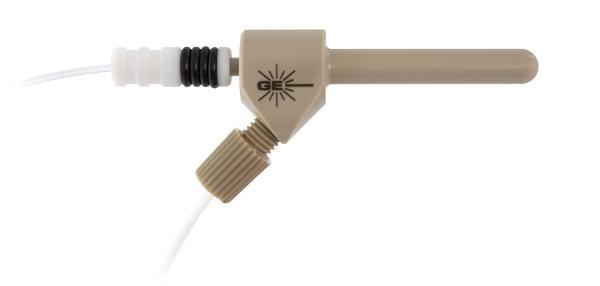
The DuraMist concentric nebulizer is made from PEEK and is the most economical inert nebulizer for high-precision analysis. It is highly sensitive, with excellent short-term precision and the highest tolerance to dissolved solids of any concentric nebulizer. It is a great “all-rounder” and the choice for the analysis of diverse sample types. Serviceability is high, as the capillary insert assembly can be replaced if needed.
The DuraMist is ideal for high-throughput labs that require a good balance between durability and sensitivity.
Material: PEEK
HF Tolerance: 5%
TDS Tolerance: 30%
Particulate Tolerance: 75 μm
Standard Uptake Rates: 0.4 and 1.0 mL/min
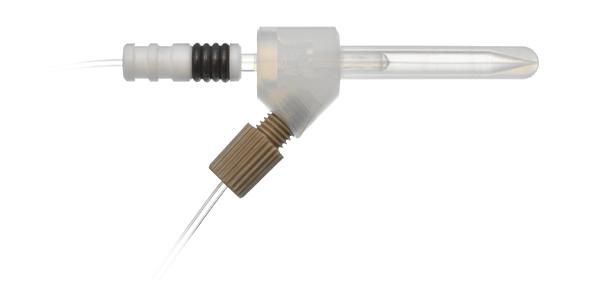
The OpalMist concentric nebulizer is made of ultra-high-purity PFA and is the choice for high-precision analyses and the best chemical resistance to HF, alkalis, and organics. In addition, the high-purity PFA construction results in the lowest elemental background levels making it ideal for ultra-trace ICP-MS work. Similar to the DuraMist, the capillary insert assembly can be replaced if needed.
The OpalMist is ideal for labs that require increased resistance to deleterious sample types and/or ultra-trace analyses.
Material: PFA
HF Tolerance: yes
TDS Tolerance: 15%
Particulate Tolerance: 75 μm
Standard Uptake Rates: 0.05, 0.1, 0.2, 0.4, 0.6, and 2.0 mL/min
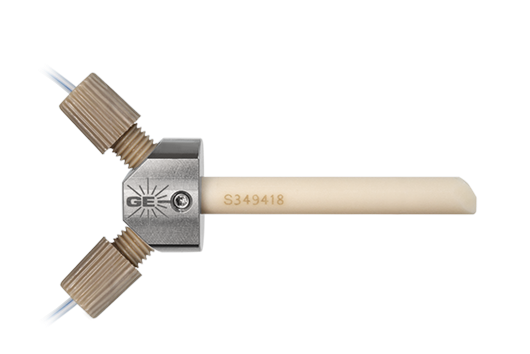
The VeeSpray is a non-concentric, V-groove design made from 99.8% alumina grade ceramic and is the choice for analyses that require the greatest resistance to large particulates. The alumina material makes it the most robust and abrasion-resistant nebulizer. As it is non-concentric, it is necessary that the sample be delivered by means of a peristaltic pump.
The VeeSpray nebulizer is virtually unblockable and is ideal for labs that are seeking a robust nebulizer but do not need the extreme sensitivity and precision offered by the DuraMist or OpalMist.
Material: Alumina ceramic
HF Tolerance: Yes
TDS Tolerance: 30%
Particulate Tolerance: 300 μm
Uptake Range: 0.6 – 3 mL/min (1.5 – 2.5 mL/min provides optimal performance)
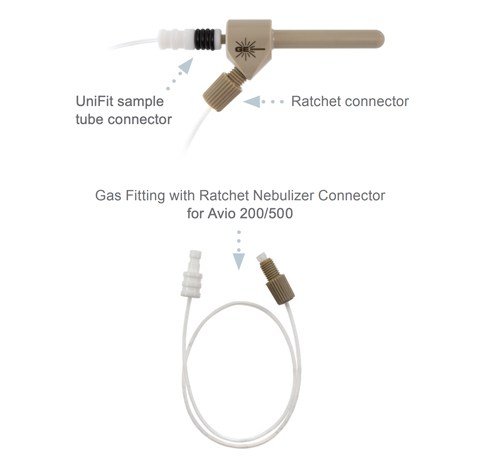
Design Features
All Glass Expansion nebulizers feature a Direct Connection (DC) gas line (Figure 4), providing an inert, metal-free, instrument-specific gas line, as listed in Table 1. The reliable DC ratchet fitting ensures a leak-free gas connection between the nebulizer and ICP, maintaining optimal back pressure for consistent day-to-day nebulizer performance.
The DuraMist and OpalMist also feature a UniFit sample connector that easily slides over the sample arm of the nebulizer, creating an excellent seal and a zero-dead-volume connection (Figure 4). The sample arm of the DuraMist and OpalMist is also compatible with Glass Expansion’s Liquid Chromatography (LC) interface kit, which provides a quick and easy connection of your LC directly to the nebulizer. The VeeSpray utilizes a second ratchet connection for the sample line.
Gas Line Ordering Information
| Manufacturer | Model | Nebulizer P/N Prefix (Axx) | Gas Line |
| Agilent Technologies® | 4100, 4200 | MP11- | 70-803-0969 |
| Agilent Technologies® | 5100, 5110, 5800, 5900 | A13- | 70-803-1105 |
| Agilent Technologies® | Vista, 700-ES | A11- | 70-803-0969 |
| Agilent Technologies® | 7700, 7800, 7900, 8800, 8900 | A13- | 70-803-1105 |
| Analytik Jena® | ICP-MS | A61- | 70-803-2002 |
| Analytik Jena® | ICP-OES | A13- | 70-803-1105 |
| Horiba® Jobin Yvon | All Models | A13- | 70-803-1105 |
| Leeman | All Models | A11- | 70-803-0969 |
| Nu Instruments® | ICP-MS | A51- | 70-803-1858 |
| Nu Instruments® | TOF-ICP-MS | A52- | 70-803-2044 |
| PerkinElmer® | Optima, PE Avio | A21- | 70-803-1070 |
| PerkinElmer® | NexION 1000, 1100, 2000, 2200, 5000 | A23- | 70-803-1449 |
| PerkinElmer® | Elan/NexION 300/350 | A22- | 70-803-1049 |
| Radom | MICAP® OES™ 1000 | A70- | 70-803-2054 |
| Shimadzu® | All Models | A41- | 70-803-1311 |
| Spectro™ |
All Models | A21- | 70-803-1070 |
| Thermo Scientific™ | PRO, 6000/7000, Q/RQ/TQ, X-Series & Neoma |
A31- | 70-803-1105 |
| Thermo Scientific™ | Neptune | A11- | 70-803-0969 |
Conclusion
Glass Expansion offers the largest range of nebulizer designs of any manufacturer, with each model ideally suited to a variety of applications. This guide was meant as a resource to help your laboratory select the best inert nebulizer to meet both the demands of the sample type and performance requirements. Should you require any further guidance in your selection, contact geusa@geicp.com (Americas) or enquiries@geicp.com (worldwide), and one of our technical experts will assist you.
